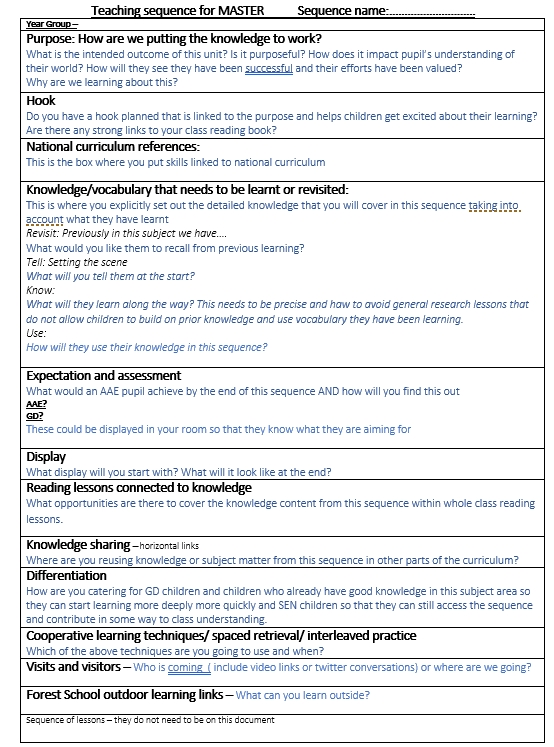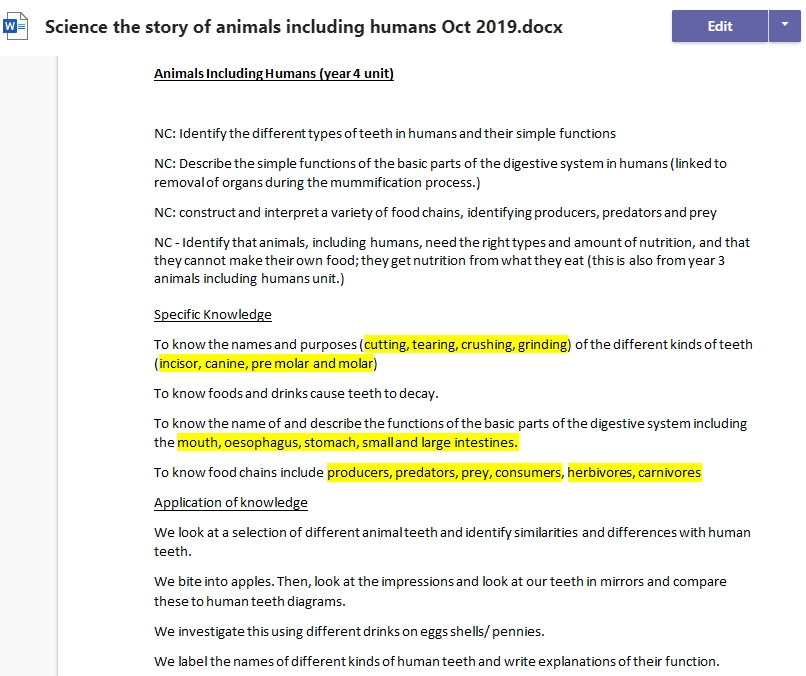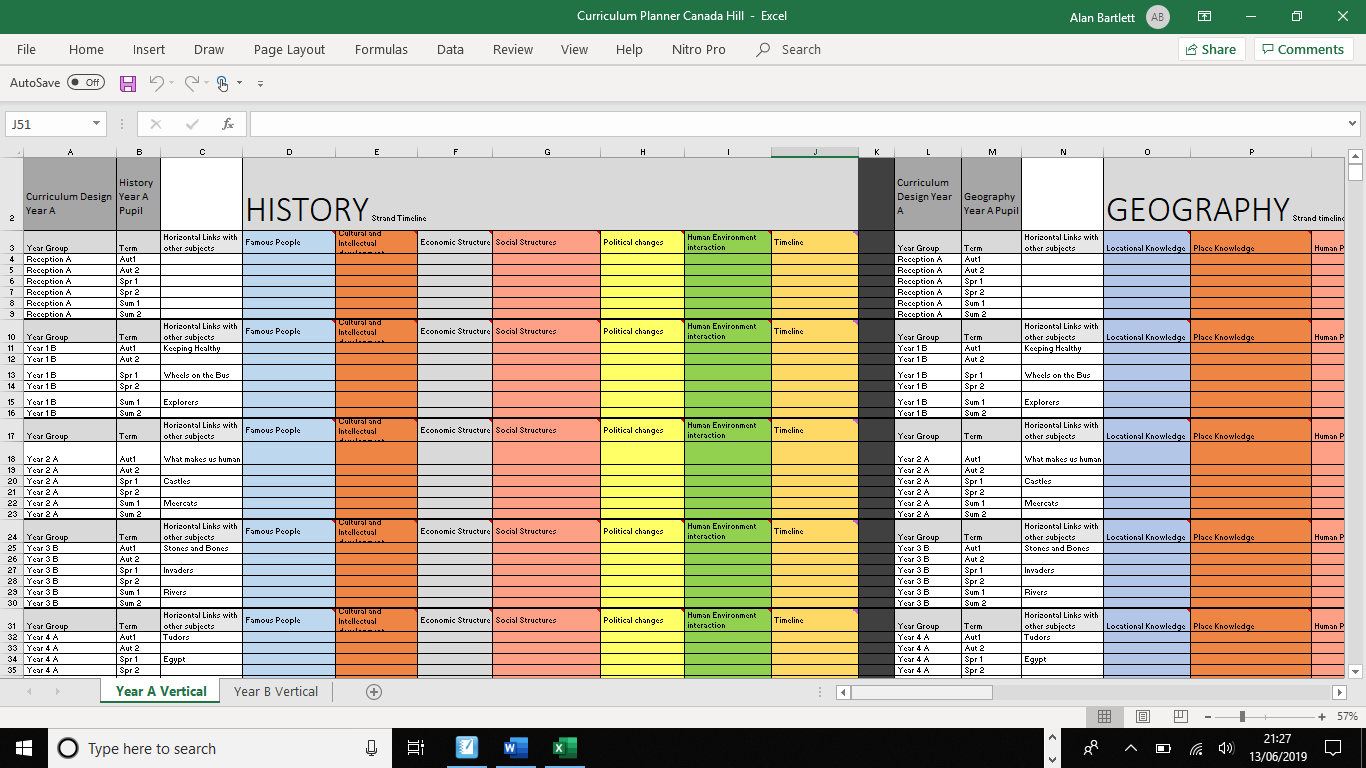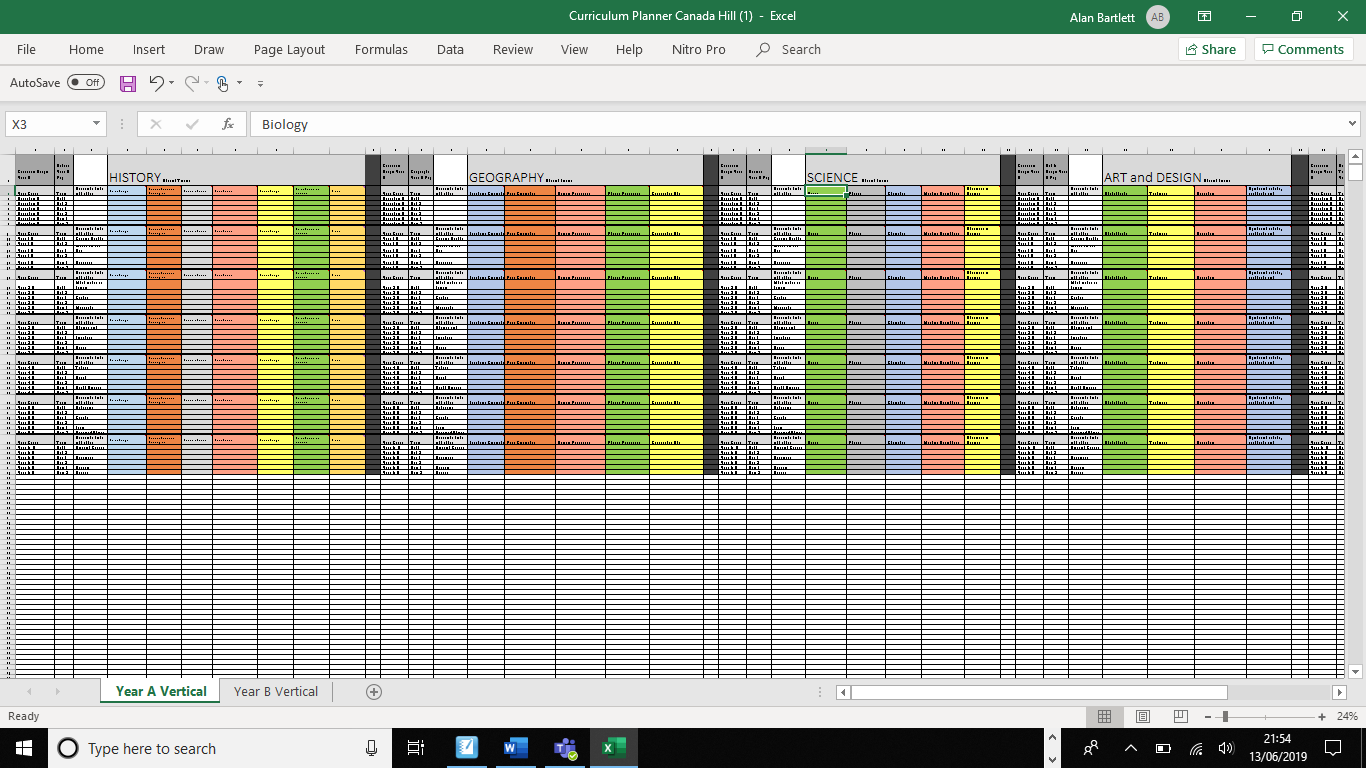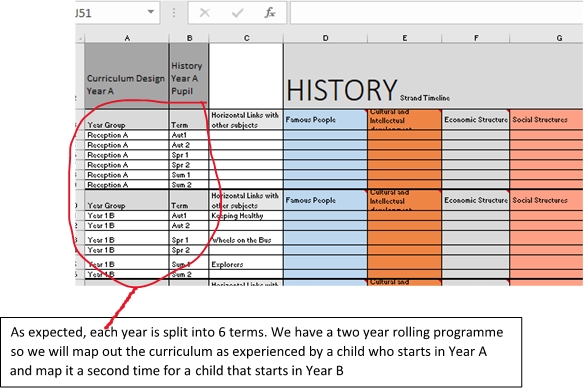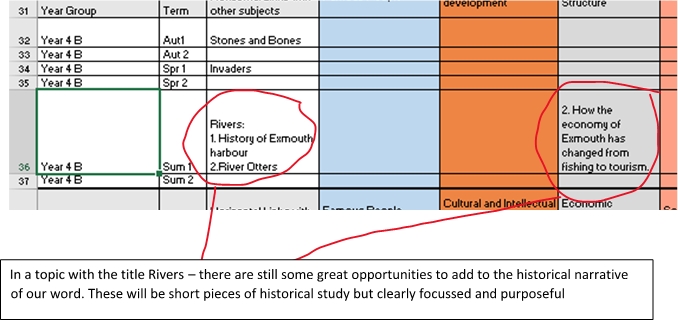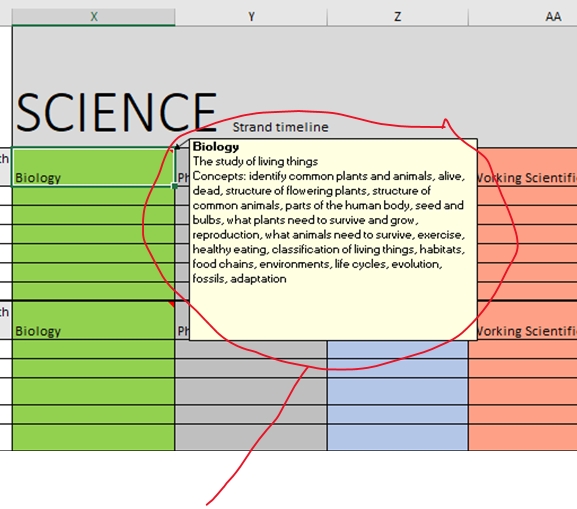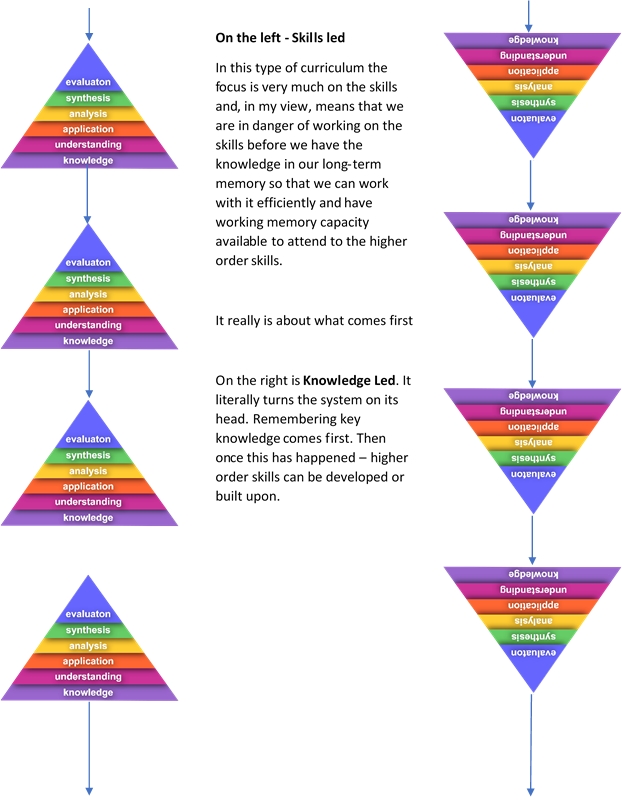Sorry for the delay in the next step of the process. I have been snowed under with the everyday complications of working in a busy school. I know I promised people copies of our first finished S-Plans but felt they needed a bit more work before I was happy to share them.
As a school we now have a curriculum overview spreadsheet that has every subject broken into its strands (as defined by us and the National Curriculum). This is a work in progress and needs to be updated and changed every term as we get further into the curriculum journey. The best thing about this document is that Subject leaders are keen to get their subjects onto the overview and broken down into meaningful strands. As we have mixed-age classes on a 2 year rolling program, this spreadsheet shows us the journey for children who start in Reception in Year A and the journey for those who start with us in Year B. This will allow us to make adjustments where necessary after we have finished our S-Plans so that the journey is as smooth as possible.
We have also put new teaching sequence overviews into place and all staff are using these to structure their thought processes when designing teaching sequences so that we are thinking about cognitive science, and our agreed approach when we are planning for learning.
We have now embarked on the momentous job of creating overviews for each strand in each academic subject in the school so that we can see the narratives we are developing within the subject over the 7 years the pupils are with us. We started with Science , as we felt that Maths and English have had much more focus over the years and are well mapped out already with countless progression documents – this is not to say that the Maths and English leads are sitting back relaxing – they have plenty to look at – but the strand planning seems more pertinent to other subjects at this point.
Science offered quite well defined strands which are essentially Biology, Chemistry, Physics, Working Scientifically, and how we tell the story of the Advances in Science.
However, as we started discussing these strands we renamed them and split the Biology strand into two. We now have – Animals Including Humans; Plants; Cause and Effect; and How Things are Made. We have then included the other two areas in these strands as we think they make more sense to be included as they are ways of exploring that narrative of that strand.
When we designed these Strand documents we tried to use similar titles to our Teaching Sequence Overviews so that the S-plans become closely and regularly integrated into the termly planning process.
I have attached our Plants S-Plan as an example and am happy to share more in a few weeks time when a lot more S-plans will have matured into final versions. The Plants S-Plan alone has had many positive impacts on our curriculum –
- we have a clear planting plan that ties into our curriculum
- our Forest School provision in KS1 has clearer aims for Science
- we have included far more Cultural Capital about our school site (finding out the age of the Giant Oak that was on the site long before the school when it was still a farm) and native trees that our classes are named after
- we have seen meaningful links to other subjects that we never knew existed – links to local history – the Giant Oak, ancient history – daffodils being brough to the country by the Romans, onions being important in many ancient cultures etc etc
- we have found repetition of learning that we can now remove – repeat as revision and then build upon for deeper learning and understanding. Year 5/6 no longer need to dissect flowers as children should know about flower parts and functions. We can concentrate on animals lifecycles and asexual reproduction in plants.
A have pasted the Plants S-Plan below – hope it helps – happy to send a copy to people – just email alan@scintilla.ai
Curriculum Strand Progression Document – Plants
EYFS
Understanding the World: ELG 14
40-60 months-Looks closely at similarities, differences, patterns and change.
ELG – Children know about similarities and differences in relation to…living things. They talk about the features of their own immediate environment and how environments might vary from one another. They make observations of…plants and explain why some things occur and talk about changes.
Exceeding- Children know that the environment and living things are influenced by human activity.
Vocabulary linked with Knowledge organiser
maple, oak, sunflower, seeds, bulbs, tubers, amaryllis, hyacinth, tulip, daffodil, pansy, grow, growth, sprout, germinate, roots, stems, leaves, flowers, petals, water, transport, water, food, light, warmth
Specific knowledge that children need to remember
- The name of their class tree and be able to identify a maple and an oak tree in the school grounds.
- They will recognise and be able to name a sunflower,
- They will know that they grow tall and that they produce sunflower seeds.
- They will know that if they plant the seeds they will get a baby sunflower
- They will recognise and be able to name bulbs and will know that amaryllis, hyacinth, tulip and daffodil flowers grow from bulbs
- They will be able to recognise the roots on a bulb and on fully grown pansies and know that the plants or the bulb uses roots to get water from the soil it is planted in.
- They will recognise a pansy and will know that it is a type of flowering plant
- They will know that not all plants have flowers
- They will look at the stems on sunflowers and pansies and will know that stems support the plant and take the water from the roots to the leaves and flowers.
- They will know that stems have small ‘pipes’ in the to take the water to the leaves and flowers. A bit like the water pipes in our homes.
- They will be able to name the parts of a pansy – leaves, stem, roots, flower, petals
- They will know that when a flower is out, it is in
- They will know that bulbs and tubers need warmth and water to sprout – they don’t need light because they are underground; or food, because they have their own food in the bulb or tuber
- They will know that seeds need warmth and water to germinate – they don’t need light because they are underground; or food, because they have their own food in the seed
- They will know that plants need water, food and light to grow
- They will know that potatoes are tubers
Application of knowledge – Autumn Term each year
- They will use their senses to experience fully grown cut flowers and dead seed heads
- Planting daffodil and tulip bulbs. They will decide what it needs to grow.
- Planting pansies in bloom. They will decide what it needs to grow.
Application of knowledge – Spring Term each year
- Observe how tulip and daffodil bulbs have grown and changed.
- Observation and discussion of Amaryllis, Hyacinths and pots of daffodils growing and dying in class.
- March- plant sunflower seeds in the greenhouse (FS). Discuss where the sunflower seeds came from and recognise that it is a cycle.
Application of knowledge – Summer Term each year
- Digging up the dead tulips and daffodils, looking at roots, bulbs, stems etc (FS)
- Planting the sunflowers that have grown along with other summer bedding plants (FS)
- Plant and harvest potatoes.
Final outcomes for assessment
Trips and visitors
Digital Literacy
PSHE links – see separate document
Year 1 and 2
NC2014
Sc1/2.1a identify and name a variety of common wild and garden plants, including deciduous and evergreen trees
Sc1/2.1b identify and describe the basic structure of a variety of common flowering plants, including trees
Sc2/2.2a observe and describe how seeds and bulbs grow into mature plants
Sc2/2.2b find out and describe how plants need water, light, air and a suitable temperature to grow and stay healthy.
Vocabulary linked with Knowledge organiser
From reception
maple, oak, sunflower, seeds, bulbs, tubers, amaryllis, hyacinth, tulip, daffodil, pansy, grow, growth, sprout, germinate, roots, stems, leaves, flowers, petals, water, transport, water, food, light, warmth
New in KS1
Canopy, branch – branches, leaf litter, twigs, trunk, leaflets, berries, fruit, buds, flower head, pollen, dispersal, dispersed, blossom, herbs, bark, dormant, sap, The Romans
Specific knowledge that children need to remember on top of revision of previous knowledge
Note that this work is reinforced through Forest School throughout the year.
Year A – Time and Thyme Again
- Know that evergreen trees do not lose their leaves in the winter – pine, holly, cedar, bay
- Know that deciduous trees do drop their leaves in the Autumn and become dormant – oak, maple, elm, willow, rowan, larch, ash, hazel, beech (Link back to animals and hibernation in Spring A)
- Know that oaks give you acorns, elm seeds are surrounded by a papery wing, hazel trees produce hazelnuts, ash trees produce ash keys, beech seeds come in prickly pods and were once valued as pig food.
- Know that daffodils were introduced to Britain by the Romans because they thought the sap had healing powers.
- Know that some plants are grown in the flower garden for decoration and some are grown in the vegetable garden for food. (History link – The Normans)
- Know that the trunk of a tree is a woody stem so has the same function as the stem of a plant
- Know that you can count the rings on a tree stump to find out the age of a tree
- To know that some of the biggest trees ( the oak by the pergola and the big trees in Forest School) on the site are over 100 years old and were here when it was Canada Hill Farm (in Year 5/6 they could work out the age by measuring the circumference of the tree and then calculating the diameter and using this to work out the age)
- Be able to label roots, leaves, trunk, branches, twigs, leaf litter, blossom on a diagram of a tree
- To know that some trees flower just like other plants and we call that flower blossom.
- To know that the flower then turns into the fruit/berry of the tree
- Know that berries/fruits and nuts are a way that the plant gets its seeds dispersed
Year B – Ready, Steady, Grow
- Identify and name these flowers: daisies, daffodils, tulips, hyacinth, amaryllis, pansies, irises, crocuses, bluebells, foxgloves (Risk Assessed), Lords and Ladies (Risk Assessed), oak, maple, elm, holly – evergreen, willow, rowan, ash, beech, cedar, larch -deciduous, pine – evergreen, hazel
- Know the difference between wild (foxglove, Lords and Ladies, daffodils, daisies, bluebells, iris) and garden plants (tulips, pansies, sunflowers, broad beans) and know that it is illegal to pick wildflowers. Know what a household plant is (hyacinth, amaryllis)
- Know that flowers produce pollen – this is what causes hayfever for some people
Application of knowledge – Forest School
- Identify trees from their leaves and appearance.
- Create own risk assessments for staying safe around plants including ‘not eating berries which are unidentified’ and specific risks with specific plants eg Lords and Ladies and Foxgloves.
- Identify and know the seeds that come from each tree as a means of identification.
- Identify which berry comes from which tree.
- Explore the different uses that the fruit from trees can have eg Using fruit in activities eg rowan berry dying, blackberry picking etc.
- Identifying the different seeds and flowers and then using them to create art work.
Tree flowers will be the Forest School focus so garden flowers and vegetables need to be classroom based.
Application of knowledge – in the classroom –
- Tear plants apart and label parts – stem, flower, petal, root, bulb (purpose comes in Y3/4)
- Investigate germination of cress seeds in dark/light. Do cress seeds germinate better in the dark or light?
- Investigate growth of sunflowers in different soil mediums.
- Plant broad beans and observe roots and structure.
- Investigate germination of cress seeds in hot/cold – Once decided on best medium from previous investigation we place one seedling in the fridge and one on a hot, sunny windowsill and monitor their growth.
Final outcomes for assessment –Work from books, class discussions and results from investigations.
Trips and visitors – Forest School every week
Digital Literacy – Watch germination and growth of sunflowers in time lapse video.
PSHE links – See separate document
Year 3 and 4
NC2014
- Sc3/2.1a identify and describe the functions of different parts of flowering plants: roots, stem/trunk, leaves and flower
- Sc3/2.1b explore the requirements of plants for life and growth (air, light, water, nutrients from soil, and room to grow) and how they vary from plant to plant
- Sc3/2.1c investigate the way in which water is transported within plants
- Sc3/2.1d explore the part that flowers play in the life cycle of flowering plants, including pollination, seed formation and seed dispersal.
Vocabulary linked with Knowledge organiser
From reception
maple, oak, sunflower, seeds, bulbs, tubers, amaryllis, hyacinth, tulip, daffodil, pansy, grow, growth, sprout, germinate, roots, stems, leaves, flowers, petals, water, transport, water, food, light, warmth
From KS1
Canopy, branch – branches, leaf litter, twigs, trunk, leaflets, berries, fruit, buds, flower head, pollen, dispersal, dispersed, blossom, herbs, bark, dormant, sap, The Romans
New in Year 3/4
Stigma, stamen, sepal, ovule, filament, anthers, nutrients, air, transported, life cycle, flowering plants, pollination, seed formation, seed dispersal, soil, requirements, functions, xylem, phloem, veins, celery, insect pollination, nectar, bees, hive, honey (from nectar not pollen), cherry, apple, leek, onion, root vegetable
Specific knowledge that children need to remember on top of revision of previous knowledge.
Year A
To know that the word tulip comes from the Persian word for turban
To recognise and label a stamen, stigma, sepal, ovule, filament, anthers and petals from a tulip flower.
To know the functions of a stamen, stigma, sepal, ovule, filament, anthers and petals from a tulip flower.
To know there are veins called xylem and phloem in some plants stems and these transport water (xylem) and food (phloem). Compare this to animals having veins for the same reason.
To know that bees and other insects pollinate flowers by accident when they are helping themselves to the sugary nectar in the flower. ALSO Onion’s pungent juices will help soothe a bee sting.
Know that you can see these veins in some plants like celery
Know that Lavender was introduced into England in the 1600s. It is said that Queen Elizabeth prized a lavender conserve (jam) at her table, so lavender was produced as a jam at that time, as well as used in teas both medicinally and for its taste. (in preparation for Year 5/6)
Know that seeds can be dispersed in a variety of ways – wind, animal, explosive, water
Year B
Revision of KS1 tree knowledge
- Know that evergreen trees do not lose their leaves in the winter – pine, holly, cedar, bay
- Know that deciduous trees do drop their leaves in the Autumn and become dormant – oak, maple, elm, willow, rowan, larch, ash, hazel, beech (we could compare this to how animals hibernate)
New
- Know that fruit trees blossom and this flower turns into a fruit containing seeds when pollinated.
Application of knowledge – Year A Autumn (Tudors)
Make leek and potato soup and link to Sir Walter Raleigh bringing potatoes to England in
Application of knowledge – Year A Spring (Tomb raiders)
Plant tulips from bulbs in boxes outside classrooms so we can look at the parts in the Summer term.
Learn that onions were an object of worship symbolizing eternity in Ancient Egypt. The Ancient Greeks used them to fortify athletes before the Olympic Games. Ans were used by the Romans for their medicinal properties see: https://www.onions-usa.org/all-about-onions/history-of-onions/
Application of knowledge – Year A Summer (Carnival)
To understand that the rainforest is an important eco-system (geography)
We will plan and investigate a fair test investigating what plants need to grow well (building on investigations in year 1 and 2 which looked at growing plants in different mediums and in dark/light.) Year 3 and 4 make choices about the variable. The planning of the investigation will be less scaffolded.
We will investigate how water is transported by plants using food dye and celery.
We will identify the parts of a flowering part (see above) and teach their function as part of the life cycle of a plant. We will teach how bees are involved in the life cycle of plants and about the different types of seed dispersal.
Wind seed dispersal – dandelions and sycamore
Hook seed dispersal – burdock on dogs
Water seed dispersal – coconuts (palm tree seeds)
Animal seed dispersal – apples, cherries by garden birds
Bursting seed dispersal – peas
Shaking seed dispersal – poppy seeds
Plant herbs (basil, oregano, parsley, rosemary, mint, lemon balm.) Children will use the basil and oregano to make pizzas in year B Spring term.
Application of knowledge – Year B Summer (From Source To Sea)
Identify types of trees by their leaves (link to classification of living things as part of Living Things and Their Habitats:
Recap from year 1 and 2:
Introduce: fruit trees – cherry, apple (ensure this is the start of the Summer so the children can see blossom.)
Plant leeks, potatoes and onions (link to previous potato growing.) Start leeks in the classroom in the Spring term (March) and onions and potatoes in April. In the Autumn term, year A we make leek and potato soup (link to Sir Walter Raleigh!)
Final outcomes for assessment Work from books, class discussions and results from investigations.
Trips and visitors Canonteign Falls. Heatree residential
Digital Literacy Watch seed dispersal in time lapse video.
PSHE links see separate document
Year 5/6
NC2014
Sc6/2.1a describe how living things are classified into broad groups according to common observable characteristics and based on similarities and differences, including micro-organisms, plants and animals
Sc6/2.1b give reasons for classifying plants and animals based on specific characteristics.
Sc5/2.1b describe the life process of reproduction in some plants and animals.
Vocabulary linked with Knowledge organiser
From reception
maple, oak, sunflower, seeds, bulbs, tubers, amaryllis, hyacinth, tulip, daffodil, pansy, grow, growth, sprout, germinate, roots, stems, leaves, flowers, petals, water, transport, water, food, light, warmth
From KS1
Canopy, branch – branches, leaf litter, twigs, trunk, leaflets, berries, fruit, buds, flower head, pollen, dispersal, dispersed, blossom, herbs, bark, dormant, sap, The Romans
New in Year 3/4
Stigma, stamen, sepal, ovule, filament, anthers, nutrients, air, transported, life cycle, flowering plants, pollination, seed formation, seed dispersal, soil, requirements, functions, xylem, phloem, veins, celery, insect pollination, nectar, bees, hive, honey (from nectar not pollen), cherry, apple, leek, onion, root vegetable
New Year 5/6
Sexual reproduction, asexual reproduction, sweet chestnut, horse chestnut (conkers), sycamore (helicopter seeds), spider plants, stem bulblets, stolon
Specific knowledge that children need to remember on top of revision of previous knowledge.
Revision of all previous knowledge
Know that Marron grass can be used to maintain sand dunes.
Application of knowledge – Autumn A :
Canonteign visit: children will have tree identification sheets to take on the trip and find the trees they should know at Canonteign. Collect leaves and nuts etc for a simple display in the classroom comparing Canonteign trees and leaves and Canada Hill tree leaves and fruits as a revision and bringing together of knowledge. Back in school, using identification sheets, which of these do we have in school. Add sycamore, sweet chestnut and horse chestnut trees.
Greek bread making- use herbs growing on site by Year 3/4 (basil, oregano, parsley, rosemary, mint). Investigating flavours for our food tech. ‘Smelly bags’ different herbs in organza bags to investigate the smell. Which ones to use for our bread making. Briefly look at history of onion again and how revered it was by Ancient Greeks – great ingredient for bread.
Tulips – Revise that tulips get their name from the Persian word for turban.
Daffodils ( narcissus) – We get the word ‘Narcissus’ from Greek mythology. A nymph called Echo fell in love with a young Greek named Narcissus, but Narcissus told her to leave him alone. Heartbroken, she lived alone until nothing but an echo of her remained. Nemesis, the God of revenge, heard the story and lured Narcissus to a pool. Narcissus, who was very handsome and quite taken with himself, saw his reflection in the pool and, as he leaned over to see better, fell in and drowned. He turned into the flower.
Application of knowledge – Summer A- Survival
Survival: Deadly 60- What not to eat in the wild. What plants could they survive on at Canada Hill – revision on knowledge or nuts, fruits, berries and herbs. Can they remember about the medicinal properties of onions? Learn how useful birch trees are in survival.
Plant poppies and peas and lavender ready for Autumn B
Application of knowledge – Autumn B:
Investigating the process of sexual and asexual reproduction in plants, we use lilies because of their anatomy. Investigation: CSI plant to dissect the lillies, identify their different parts and learn how they can be cloned. Parts they must learn: Petal, carpel, sepal, stamen, style, stigma, filament, stem, anther, root, ovary. Key words to learn: pollination, male, female, germination, seed dispersal. Revising the classification names of living things. We don’t need to do this as it has been loads in previous years – they simply need to revise this. We should grow new plants from different parts of parent plants. Learn that bulbs reproduce asexually by producing more bulbs. Daffodils can be propagated asexually by offsets, stem bulblets, and division of basal sections. Offsets, are bulbs grown from bulblets, which are miniature bulbs produced on the scales and stems of the parent bulb. … Stem bulblets, are underground bulbils produced on the stem of the daffodil.
We will reproduce some spider plants – Spider plants reproduce asexually by sending out stolons on which smaller plants grow. … Although both spider plants and strawberries have flowers and develop seeds which is sexual reproduction, the quickest way for the plants to reproduce is through the stolens or runners, thus ensuring a more efficient survival.
We will grow lavender in our class planters. This is where we will release our butterflies.
We will also grow poppies, peas and daffodils (planted in Summer A). We will use our poppies for cultural capital opportunities: armed forces day, remembrance day.
We will use the poppies, peas and daffodils in our revision of plant life cycles and seed dispersal.
Application of knowledge – Spring B:
Trip to Dawlish warren- we will spend time looking at Marron grass. They use the natural sand dune creating properties of marron grass to protect our coastline.
Final outcomes for assessment
Trips and visitors
Digital Literacy
PSHE links












